Importance of Japanese beetles
We are all familiar with Japanese beetles (Popillia japonica) and the damage caused by them to our turf grass, beautiful ornamentals and crops. Being native to Japan, Japanese beetles were accidentally introduced to the U.S. in 1916 and have become a major turf pest since.
Identification
Japanese beetle adults are easy to identify due to their oval shape and attractive shiny metallic-green color with a row of white spots around the abdomen (Photo 1). They can be easily spotted when feeding on leaves, flowers and fruits from June through July. Japanese beetle grubs are C-shaped (when disturbed), whitish in color with a yellowish-brown colored head capsule and three pairs of thoracic legs (Photo 2).
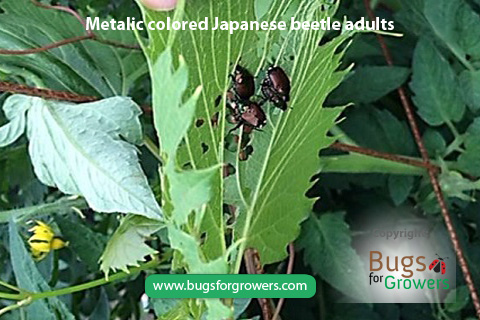

Life Cycle
Japanese beetle adults mate while feeding (Photo 3). After mating, females lay eggs in the soil near the grass root zone. Eggs hatch within a week into tiny grubs, which immediately start feeding on grass roots and organic matter. Grubs pass through three developmental stages from August through October. During this time they continuously feed on grass roots, However, when the temperature starts cooling down at the end of September these grubs start moving deep into the soil for overwintering. Throughout the winter they live in earthen cocoons deep in the soil and as soon as temperatures start warming up in the April, they move back into the turf root zone and start feeding on the roots again and then enter into the fourth stage. These matured grubs then pupate in the soil in early June. Japanese beetle adults will emerge from the pupae within 1-2 weeks and the life cycle continues.
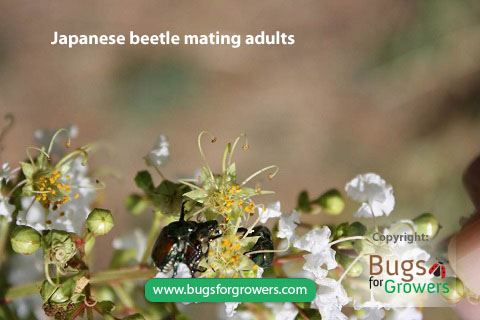
Damage caused by Japanese beetles
Adults of Japanese beetles cause severe damage to leaves (Photo 4), flowers and ripening fruits whereas their grubs cause damage to roots (Photo 5). In the case of severe infestation, adult Japanese beetles completely skeletonize all the leaves that easily fall off the plants and eventually defoliate the whole plants. Severe damage caused by grubs to turf grass is easily recognized as the localized patches of dead turf grass are noticed throughout the lawn (Photo 6). These patches of dead grass are always confused with symptoms of water stress. As the feeding activity of grubs increases, the small patches of dead turf join together to form the large areas of dead turf. This dead turf is generally loose and can be easily picked up like a piece of carpet. The most significant sign of the presence of Japanese beetle grubs in the lawn is that the infested area is destroyed by diggings animals such as raccoons, skunks or birds that are looking for grubs to feast on them.
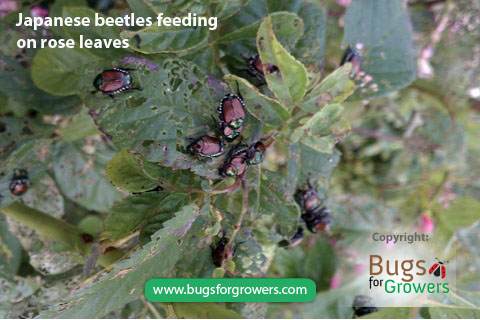
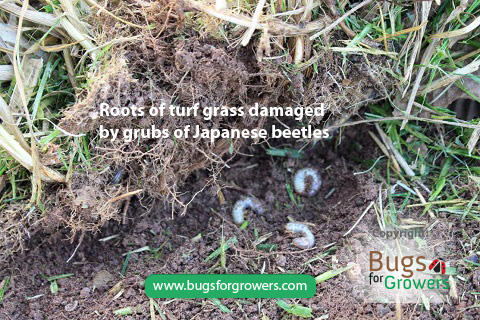
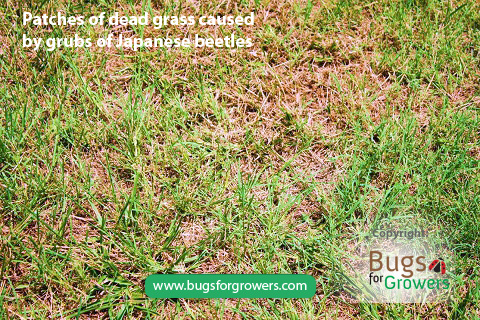
Biological Control
To reduce future outbreaks of Japanese beetles and the damage caused by them to ornamentals and turf next summer, it is essential to kill the overwintering grub population now. Beneficial entomopathogenic Heterorhabditis bacteriophora nematodes (Photo 7) also called insect-parasitic nematodes have been used as biological control agents to kill both grubs and pupae of Japanese beetles. Heterorhabditis bacteriophora nematodes can be applied three times a year. The first application within the first 2 weeks of October (early fall) will target grubs before they move deep in the soil for overwintering. The second application in the April targets the grubs that survived the first nematode application and moved back from their overwintering sites into the turf root-zone, and the third application in August targets newly hatched grubs.
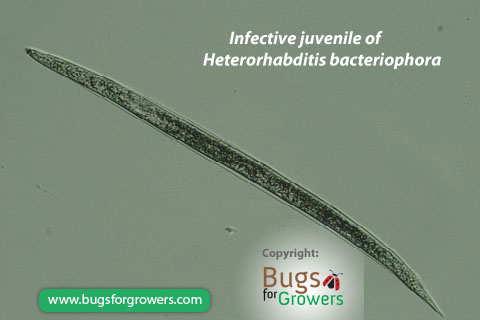
How do beneficial entomopathogenic nematode kill grubs?
Beneficial Heterorhabditis bacteriophora nematodes are commercially available and can be easily applied at the rate 23,000 nematodes per square foot of area by simplly using water cans (Photo 8) or knapsack sprayers. These nematodes always carry several cells of symbiotic bacteria called Photorhabdus luminescens in their gut and use them as weapons to kill their insect hosts. When the entomopathogenic nematodes are applied to the soil surface or thatch layer, they move into the soil and look for Japanese beetle grubs. Once the nematodes find a grub, they enter the grub’s body cavity via natural openings such as the mouth, anus or spiracles and release the symbiotic bacteria from their gut into the grub’s blood. In the grub’s blood, the multiplying nematode-bacterium complex causes septicemia and usually kills the grubs within 48 hours after infection. Nematodes generally feed on multiplying bacteria, mature into adults, reproduce and then emerge as infective juveniles from the cadaver to seek new Japanese beetle grubs or other insect hosts that present are in the soil.
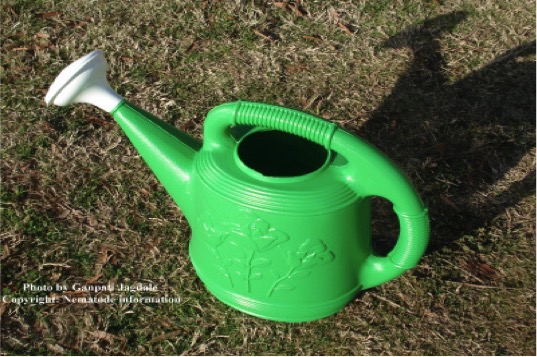
Research Papers
Grewal, P.S., Koppenhofer, A.M., and Choo, H.Y., 2005. Lawn, turfgrass and Pasture applications. In: Nematodes As Biocontrol Agents. Grewal, P.S. Ehlers, R.-U., Shapiro-Ilan, D. (eds.). CAB publishing, CAB International, Oxon. Pp 147-166.
Koppenhofer, A.M., Fuzy, E.M., Crocker, R.L., Gelernter, W.D. and Polavarapu, S. 2004. Pathogenicity of Heterorhabditis bacteriophora, Steinernema glaseri, and S. scarabaei (Rhabditida : Heterorhabditidae, Steinernematidae) against 12 white grub species (Coleoptera : Scarabaeidae). Biocontrol Science and Technology 14: 87-92.
Maneesakorn, P., An, R., Grewal, P.S.and Chandrapatya, A. 2010. Virulence of our new strains of entomopathogenic nematodes from Thailand against second instar larva of the Japanese beetle, Popillia japonica (Coleoptera: Scarabaeidae). Thai Journal of Agricultural Science 43: 61-66.
Mannion, C.M., McLane, W., Klein, M.G., Moyseenko, J., Oliver, J.B. and Cowan D. 2001. Management of early-instar Japanese beetle (Coleoptera : Scarabaeidae) in field-grown nursery crops. Journal of Economic Entomology 94: 1151-1161.
Power, K.T., An, R. and Grewal, PS. 2009. Effectiveness of Heterohabditis bacteriophora strain GPS11 applications targeted against different instars of the Japanese beetle Popillia japonica. Biological Control 48: 232-236.
